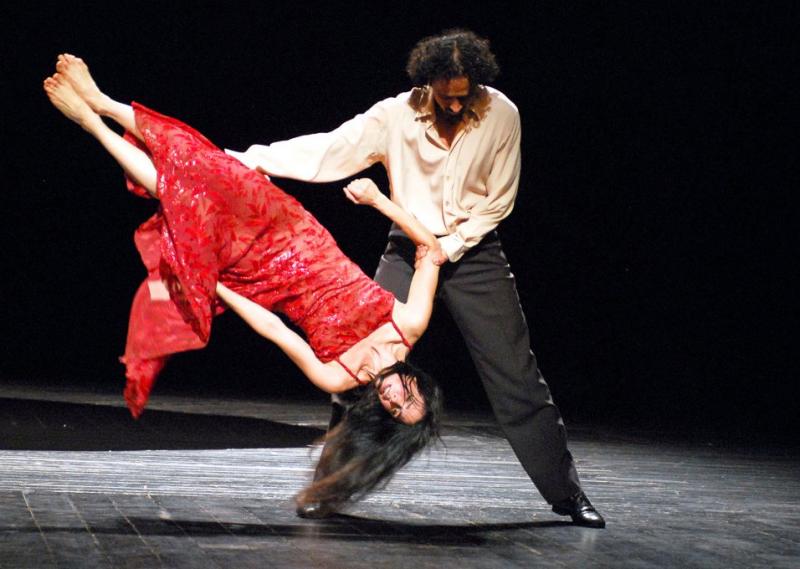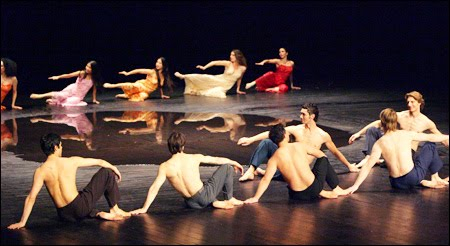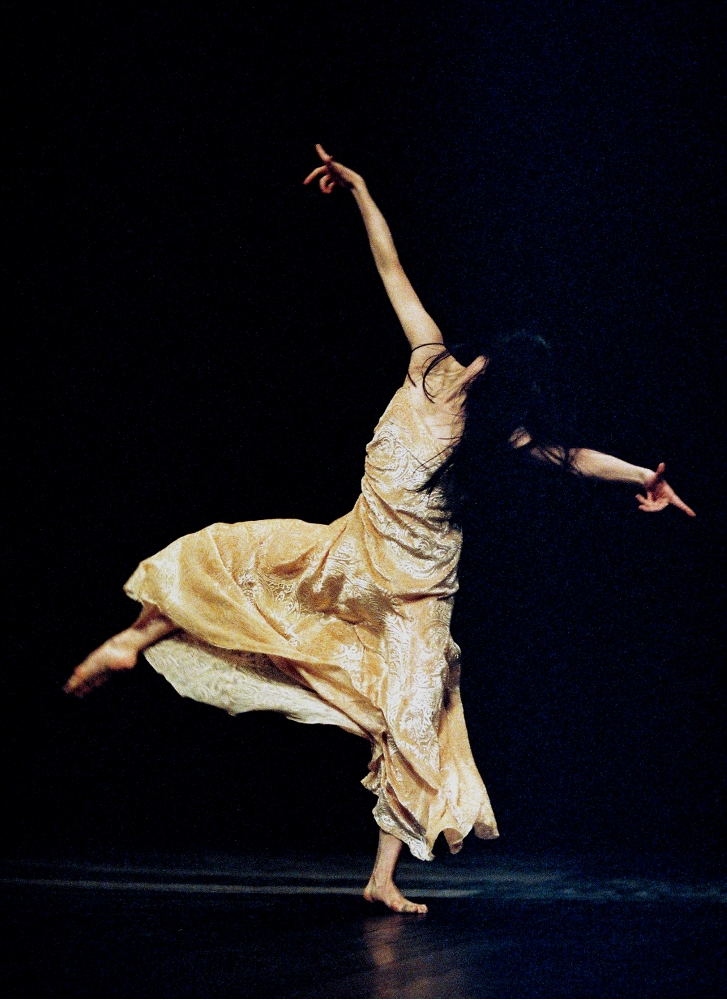Nefés, Tanztheater Wuppertal Pina Bausch, Sadler's Wells | reviews, news & interviews
Nefés, Tanztheater Wuppertal Pina Bausch, Sadler's Wells
Nefés, Tanztheater Wuppertal Pina Bausch, Sadler's Wells
Bausch makes of Istanbul a production whose jewels don't compensate for the meagre set

Istanbul, even more than Rome, is the point in the world where tectonic plates of civilisations collide: Europe, Arabia and Asia, Muslim Istanbul and Christian Constantinople, fundamentalists and secularists, 21st-century women and 15th-century men. The smells of hookahs, roses and fish are part of the magic the city has from time immemorial radiated, beckoning traders and dealers, visitors and adventurers, to a place of shifting histories and irresistible mystery.
First, a cruel disappointment in the set, with expectations roused by the gigantic earthworks, mountains of flowers, vast treetrunks and tumbling rocks in other productions. Here, for the luminous city of Aya Sofia, cavernous cisterns and the Golden Horn, designer Peter Pabst offered an empty black stage with a meagre little pool of water in it. He confessed to Wim Wenders, the maker of the film Pina, that he had felt unable to capture Istanbul - it's a rare failure from him. True, it starts with a sudsy hammam session, and later on we had a glorious water shower, ablaze with light, for a short time, but much more atmosphere comes from the eclectic Eurasian musical assemblage by Matthias Burkert and Andreas Eisenschneider in which Turkish folk, heavy rock and electronica pile Arabic riffs over dark, syncopated beats, and Tom Waits croons “All the World is Green” in a wheezy old-man’s voice (see tube at end).
Nefés is, like other "World Cities" productions, a bazaar of impressions and touristy jokes that keeps an eye firmly on its host audience. There’s a bazaar scene, a Turkish delight sketch and a hammam. Its view of male-female behaviour tends more to the Mills & Boon (or possibly Turkish equivalent) than I’m quite used to from Bausch. Women are gowned in white and pink, princesses calling the shots, while the men fetch, carry and manipulate them as the sex-goddesses require for their fantasy - that theatrical trope we expect from Bausch, but in the past she'd have got some fairly savage subtext out of it as well.
It’s as if the Istanbul culture authorities wanted a recognisable location production from the Bausch factory, and so, rather than do something to surprise and experiment, she obliged her hosts. A trade took place. Being a Bausch, it has episodes of wit and beauty, but being this kind of Bausch the whole doesn't have an authorial embrace around it claiming the material for her own purposes. (This series, from Viktor to ...como el musguito, took her 23 years - have any other major choreographers changed their motifs and devices so little over 23 years?)
 All the same, Nefés is more textured than Ten Chi, or Nur Du either (the Los Angeles one). "Nefés" means "breath", and there's life and sweetness in some of the male-female vignettes. There are also three or four little jewels of choreographed fantasy that ought to be preserved under glass to look at and love forever. A woman bearing water bags on her head apparently climbing a staircase in air, her feet walking in the hands of two men. Another wee creature being treated as a baton one moment and a paper plane another, twirled and launched by a relay of men with impressive dexterity and gravity-defying ingenuity - a child having a whale of a time. An exultant final chain of men shuffling ingeniously along the floor draping their arms over their knees invitingly like Michelangelo’s Adam, while the women reciprocate with a line of captivatingly delighted, embarrassed and aroused squirms. (Pictured above left)
All the same, Nefés is more textured than Ten Chi, or Nur Du either (the Los Angeles one). "Nefés" means "breath", and there's life and sweetness in some of the male-female vignettes. There are also three or four little jewels of choreographed fantasy that ought to be preserved under glass to look at and love forever. A woman bearing water bags on her head apparently climbing a staircase in air, her feet walking in the hands of two men. Another wee creature being treated as a baton one moment and a paper plane another, twirled and launched by a relay of men with impressive dexterity and gravity-defying ingenuity - a child having a whale of a time. An exultant final chain of men shuffling ingeniously along the floor draping their arms over their knees invitingly like Michelangelo’s Adam, while the women reciprocate with a line of captivatingly delighted, embarrassed and aroused squirms. (Pictured above left)
 If not much of Nefés’s choreography or staging feels particularly Turkish it has an intriguing music-hall flexibility to it, bawdy one moment, spooky the next. A funny sequence of a matron turning again and again between doing the washing-up and an exceptionally fast bonk segues faster than you can track into a discomfiting view of men slouching expectantly on chairs while women crawl submissively on all-fours between them. That’s more like our Pina.
If not much of Nefés’s choreography or staging feels particularly Turkish it has an intriguing music-hall flexibility to it, bawdy one moment, spooky the next. A funny sequence of a matron turning again and again between doing the washing-up and an exceptionally fast bonk segues faster than you can track into a discomfiting view of men slouching expectantly on chairs while women crawl submissively on all-fours between them. That’s more like our Pina.
So is another surreal and arousing scene where the women line up in their pink and white gowns, their long hair entirely shrouding their faces, and the men go up to each and part the hair just enough to find a mouth and kiss it. This is the ambiguous bite, where fantasy comes up against social politics, that harks back to the strength of Viktor, the first in the series, drawing upon Rome 16 years earlier.
The resonant new feature is Bausch's evidently growing focus on younger men, who have some terrific, almost inarticulately thrashing solos where impulses seem to crash against each other and they kick ass against unseen enemies. That part feels personally observed and felt by Bausch, the mother of a son, whose senses were acutely attuned to such things. Young Turkish men must have more irreconcilable pressures than most youths in the world, given Istanbul’s overflowing melting-pot of time and traditions. The dancers exhaust themselves - one throws himself into the pond to cool down, panting hard, for it seems Bausch’s choreography took him to his limits.
- Nefés is at Sadler's Wells Theatre, London, tonight
- Agua is at the Barbican Theatre, London, on Thursday and Friday
- The Pina Bausch World Cities season continues until 9 July
Hear Tom Waits sing 'All the World is Green', as used by Bausch in Nefés
Buy
Share this article
Add comment
The future of Arts Journalism
You can stop theartsdesk.com closing!
We urgently need financing to survive. Our fundraising drive has thus far raised £49,000 but we need to reach £100,000 or we will be forced to close. Please contribute here: https://gofund.me/c3f6033d
And if you can forward this information to anyone who might assist, we’d be grateful.

Subscribe to theartsdesk.com
Thank you for continuing to read our work on theartsdesk.com. For unlimited access to every article in its entirety, including our archive of more than 15,000 pieces, we're asking for £5 per month or £40 per year. We feel it's a very good deal, and hope you do too.
To take a subscription now simply click here.
And if you're looking for that extra gift for a friend or family member, why not treat them to a theartsdesk.com gift subscription?
more Dance
 'We are bowled over!' Thank you for your messages of love and support
Much-appreciated words of commendation from readers and the cultural community
'We are bowled over!' Thank you for your messages of love and support
Much-appreciated words of commendation from readers and the cultural community
 R:Evolution, English National Ballet, Sadler's Wells review - a vibrant survey of ballet in four acts
ENB set the bar high with this mixed bill, but they meet its challenges thrillingly
R:Evolution, English National Ballet, Sadler's Wells review - a vibrant survey of ballet in four acts
ENB set the bar high with this mixed bill, but they meet its challenges thrillingly
 Like Water for Chocolate, Royal Ballet review - splendid dancing and sets, but there's too much plot
Christopher Wheeldon's version looks great but is too muddling to connect with fully
Like Water for Chocolate, Royal Ballet review - splendid dancing and sets, but there's too much plot
Christopher Wheeldon's version looks great but is too muddling to connect with fully
 iD-Reloaded, Cirque Éloize, Marlowe Theatre, Canterbury review - attitude, energy and invention
A riotous blend of urban dance music, hip hop and contemporary circus
iD-Reloaded, Cirque Éloize, Marlowe Theatre, Canterbury review - attitude, energy and invention
A riotous blend of urban dance music, hip hop and contemporary circus
 How to be a Dancer in 72,000 Easy Lessons, Teaċ Daṁsa review - a riveting account of a life in dance
Michael Keegan-Dolan's unique hybrid of physical theatre and comic monologue
How to be a Dancer in 72,000 Easy Lessons, Teaċ Daṁsa review - a riveting account of a life in dance
Michael Keegan-Dolan's unique hybrid of physical theatre and comic monologue
 A Single Man, Linbury Theatre review - an anatomy of melancholy, with breaks in the clouds
Ed Watson and Jonathan Goddard are extraordinary in Jonathan Watkins' dance theatre adaptation of Isherwood's novel
A Single Man, Linbury Theatre review - an anatomy of melancholy, with breaks in the clouds
Ed Watson and Jonathan Goddard are extraordinary in Jonathan Watkins' dance theatre adaptation of Isherwood's novel
 Peaky Blinders: The Redemption of Thomas Shelby, Rambert, Sadler's Wells review - exciting dancing, if you can see it
Six TV series reduced to 100 minutes' dance time doesn't quite compute
Peaky Blinders: The Redemption of Thomas Shelby, Rambert, Sadler's Wells review - exciting dancing, if you can see it
Six TV series reduced to 100 minutes' dance time doesn't quite compute
 Giselle, National Ballet of Japan review - return of a classic, refreshed and impeccably danced
First visit by Miyako Yoshida's company leaves you wanting more
Giselle, National Ballet of Japan review - return of a classic, refreshed and impeccably danced
First visit by Miyako Yoshida's company leaves you wanting more
 Quadrophenia, Sadler's Wells review - missed opportunity to give new stage life to a Who classic
The brilliant cast need a tighter score and a stronger narrative
Quadrophenia, Sadler's Wells review - missed opportunity to give new stage life to a Who classic
The brilliant cast need a tighter score and a stronger narrative
 The Midnight Bell, Sadler's Wells review - a first reprise for one of Matthew Bourne's most compelling shows to date
The after-hours lives of the sad and lonely are drawn with compassion, originality and skill
The Midnight Bell, Sadler's Wells review - a first reprise for one of Matthew Bourne's most compelling shows to date
The after-hours lives of the sad and lonely are drawn with compassion, originality and skill
 Ballet to Broadway: Wheeldon Works, Royal Ballet review - the impressive range and reach of Christopher Wheeldon's craft
The title says it: as dancemaker, as creative magnet, the man clearly works his socks off
Ballet to Broadway: Wheeldon Works, Royal Ballet review - the impressive range and reach of Christopher Wheeldon's craft
The title says it: as dancemaker, as creative magnet, the man clearly works his socks off
 The Forsythe Programme, English National Ballet review - brains, beauty and bravura
Once again the veteran choreographer and maverick William Forsythe raises ENB's game
The Forsythe Programme, English National Ballet review - brains, beauty and bravura
Once again the veteran choreographer and maverick William Forsythe raises ENB's game

Comments
"have any other major